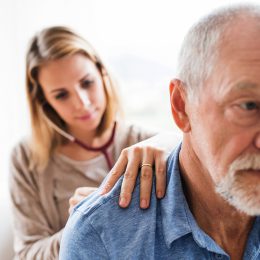5 Back Pain Myths, Debunked
Clearing up back pain confusion can be a first step to clearing up back pain itself!

Back pain, especially the kind that affects your lower back, is incredibly common. One study notes that across the world, it’s the leading cause of limited activity and absenteeism from work. The World Health Organization adds that in most cases, the origins of back pain remain unknown, but that risk factors can include aging, being overweight, occupational posture, and even depression symptoms.
“Back pain symptoms vary from person to person, and due to the range of issues, from minor to more serious, there can be a lot of confusion associated with back pain care,” says Saad Chaudhary, M.D., associate professor of orthopedics and orthopedic surgeon at Mount Sinai in New York.
Let’s separate the myths from the truths. It can be the first step in narrowing down what’s causing your pain and treating it effectively. Then, try our top exercise recommendations to bring relief and keep back pain at bay.
Back Pain Myth #1: Injuries or Accidents Are Largely to Blame
It’s true that you can develop back pain from a traumatic event like falling off a ladder or slipping on a patch of ice. But most back pain problems develop over time from wear and tear on the discs and soft tissues around the spine, says Dr. Chaudhary.
That means back pain becomes more likely as you age, especially with changes in bone density that can affect the spine. Because of that, it’s important to focus on spine health even if you don’t have pain yet.
One particularly powerful prevention tool is exercise. One study found that regular activity helped maintain bone density in the spine and hip, for example. The findings held true even for those over age 55 who were already experiencing bone density changes.
Back Pain Myth #2: Rest Is Best
Although rest is important and was for many years widely recommended for back pain, doctors now understand that movement is a far more effective treatment, according to doctor of physical therapy and strength coach Carol Mack, D.P.T., C.S.C.S., of CLE Sports & Performance in Cleveland.
“Gentle movement is the way to go with back pain,” Mack says. “Typically, it’s good to move in the opposite direction from what’s painful. Even a small amount of movement is beneficial.”
For example, if it hurts to bend forward, she suggests spending time standing tall or even leaning backwards slightly (if it doesn’t hurt). If leaning to one side is painful, doing a side bend in the other direction can help provide more balance.
Back Pain Myth #3: Back Pain Only Affects Those Who Are Overweight
Having excess weight does increase your chance of having more back pain episodes and microtrauma to the spine, says Dr. Chaudhary. But that certainly doesn’t mean that being thin or even being fit brings your risk to zero, he adds.
Anyone of any size can experience back pain. Remember, as we debunked in Myth #1, the majority of back pain problems stem from wear-and-tear issues that stack up of time.
Because of that, spine health strategies like getting more movement into every day should be employed by everyone, not just those who may be higher risk. (See “Top Exercises to Ease Back Pain,” below, for good strategies to try.)
Back Pain Myth #4: Medical Imaging Can Reveal the Source of Your Back Pain
Sure, if you’ve had a fall or other injury and your back hurts, it’s not unusual for your doctor to order X-rays or use other imaging techniques. But you shouldn’t be surprised if the images don’t actually pinpoint the source of your pain. These images may not lead doctors right to the source, but they can be useful in ruling out severe damage.
“It’s important to know that imaging studies may not pinpoint one specific cause for back pain,” says Dr. Chaudhary. “And many people can have back pain with relatively normal imaging.
“It’s critical to have a thorough physical examination and evaluation by a spinal specialist for prolonged low back pain,” he adds.
This is especially true if you are also experiencing neurological symptoms, including weakness and numbness.
Back Pain Myth #5: Surgery Is Necessary if a Herniated Disc Is Involved
A disc is the round cushion between each of the vertebra that acts like a shock absorber for the spine. When part of it is pushed out of alignment, it’s called herniated, slipped, bulged, or ruptured.
Whatever term is used, this herniation can occur in any part of the spine. But the problem is more common in the lower back and neck, according to the American Association of Neurological Surgeons.
If the disc isn’t pressing on a nerve, you may experience no pain at all — in fact, you may not even realize it’s herniated. Even if it does affect a nerve and cause pain, Dr. Chaudhary says that doesn’t automatically mean surgery.
In fact, for many patients, your doctor will likely try a range of non-surgical options first. These include:
- Physical therapy
- Electrical nerve stimulation
- Anti-inflammatory medications
- Injection-based treatments like steroids
- Lifestyle modifications like specific exercises, eating healthy foods, and quitting smoking
Back pain is frustrating, disruptive to your life and, well, painful, of course. But the biggest myth of all is that you have limited options when it comes to treating the pain.
Top Exercises to Ease Back Pain
Whether you have constant pain or stiffness that comes and goes, its helpful to put some strategies in place — especially regular exercise — that can help you maintain spinal health now and into the future. Discuss your exercise options with your doctor. With their OK, give these moves a try.
- Seated Row
Subscribe to our newsletter
It's quick and easy. You could be one of the 13 million people who are eligible.
Already a member? Click to discover our 15,000+ participating locations.
Follow Us
Grab a resistance band, and sit tall in a chair with your legs extended, heels touching the floor and toes pointing up. Place the center of the band behind the soles of your feet. If you’re using a long exercise band, you may need to loop it around your feet once or twice.
Grab the ends of the band with both hands, arms extended and palms facing each other. Sitting nice and tall, bend at the elbows and pull the band toward your core, squeezing your shoulder blades together. Slowly return to the starting position. That’s one rep. Perform three sets of 10 to 12 reps.
Learn more by checking out the 10 Best and Worst Exercises for Lower Back Pain here.
- Bridge Pose
To do a basic Bridge Pose: Lie on your back with knees bent, feet flat on the floor about hip-width apart, and heels a few inches away from your buttocks. Press your arms into the floor for support, and brace your core to minimize the arch in your lower back.
Push through your heels and squeeze your glutes to lift your hips up until your body forms a straight line from your knees to shoulders. Hold this position for four to eight breaths. Slowly lower your hips to return to starting position. Repeat for three to five reps total.
Learn more about variations of this exercise show in the video by checking out Bridge Progressions.
- Daily Stretches
Learn more about the stretches shown in this video by checking out the 4 Essential Moves for a Healthy Back here.
Take Your Favorite SilverSneakers Classes Online!
SilverSneakers members can access live fitness classes and wellness workshops through SilverSneakers LIVE. See the latest schedule and RSVP for classes here.
Not a member? If you have a Medicare Plan, it may include SilverSneakers — at no additional cost. Check your eligibility instantly here.





